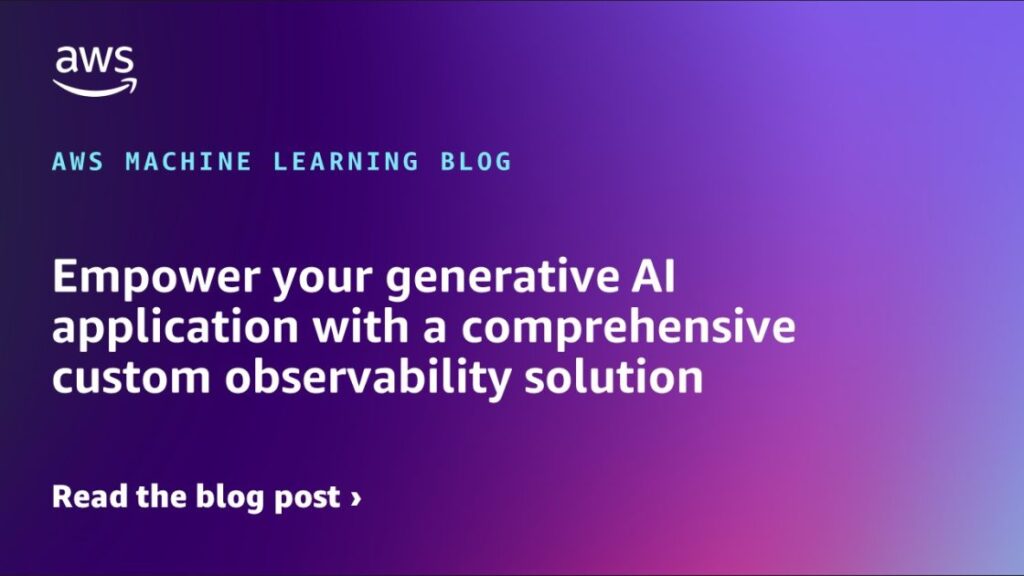Enhancing Generative AI: The Power of Observability and Evaluation
In recent months, the landscape of generative AI has experienced dynamic growth and innovation. As these applications evolve, developers, data scientists, and stakeholders are increasingly realizing the significance of observability and evaluation. So, what exactly do these terms mean?
Understanding Observability and Evaluation
Observability is the ability to peek inside a system’s operations by examining its outputs, logs, and metrics. It acts as a diagnostic tool, allowing developers to understand how their applications function. On the flip side, evaluation is the process of assessing the quality and relevance of the outputs these generative models produce, fostering an environment of continuous enhancement.
Together, observability and evaluation are essential for troubleshooting issues, pinpointing performance bottlenecks, and optimizing applications. Imagine effortlessly monitoring how your generative AI system behaves and receiving feedback on its outputs—this is how observability empowers creators.
The Amazon Bedrock Advantage
With Amazon Bedrock, these concepts become even more critical. This fully managed service provides access to a variety of high-performing foundation models (FMs) from leading AI organizations through a single API. Noteworthy names like AI21 Labs, Anthropic, Cohere, Meta, Stability AI, and Amazon make powerful models available while ensuring security, privacy, and responsible AI practices.
As applications become more complex and scale grows, robust observability and evaluation mechanisms are imperative for sustaining high performance and user satisfaction.
Crafting a Custom Observability Solution
For users of Amazon Bedrock, we’ve developed a user-friendly observability solution that can be easily implemented with a few essential components. This is facilitated using decorators within your application code to capture vital metadata, such as input prompts, output results, runtime, and custom data. This approach ensures security, flexibility, and seamless integration with AWS services.
A standout feature of our custom solution is support for Retrieval Augmented Generation (RAG) evaluation, allowing you to measure response quality and relevance. This assessment enables developers to identify areas ripe for improvement and adjust their knowledge bases or models as necessary.
Getting Started: A Step-by-Step Guide
If you’re interested in deploying this observability and evaluation solution within your Amazon Bedrock applications, here’s a brief preview of what you’ll learn:
- The importance of observability and evaluation in generating quality outputs
- Key features and benefits of the proposed solution
- Hands-on implementation guidance
- Best practices for seamlessly incorporating these functionalities into your workflows
Prerequisites
Before diving into the implementation, it’s crucial to check the prerequisites required to set up effectively.
Overview of the Observability Solution
Our observability solution allows users to monitor interactions with various components of Amazon Bedrock by utilizing decorators in their source code. Here’s what you can expect:
- Decorator Integration: Easily decorate your functions that call Amazon Bedrock APIs to log inputs, outputs, and additional metadata.
- Flexible Logging: Store logs either in local storage or on Amazon S3, ensuring integration with your existing monitoring setup.
- Dynamic Data Partitioning: Achieve logical separation of observability data based on workflows—simplifying future data analysis.
- Security First: Designed with AWS security best practices, maintaining the integrity of your data.
- Cost Efficiency: Leveraging serverless technology ensures that observability infrastructure remains affordable.
- Multi-Language Support: The solution is available in both Python and Node.js, accommodating various coding preferences.
See the Architecture in Action
Our observability solution architecturally comprises several distinct steps. When you decorate your application code with @bedrock_logs.watch, logging kicks in, feeding data streams through Amazon Data Firehose and storing them securely on Amazon S3.
Kickstarting Your Experience
To help you dive into the observability solution, we’ve made example notebooks available in our GitHub repository. These notebooks cover how to integrate the solution into your Amazon Bedrock application while illustrating various use cases.
Here’s how you can start:
- Clone our GitHub repository:
git clone https://github.com/aws-samples/amazon-bedrock-samples.git - Navigate to the observability solution directory:
cd amazon-bedrock-samples/evaluation-observe/Custom-Observability-Solution - Follow the README instructions to set up the AWS resources.
- Open the Jupyter notebooks and explore various examples.
Optimizing Performance with Key Features
Our solution streamlines observability and evaluation across your generative AI applications. Key attributes include:
- Decorator-Based Implementation: Effortlessly integrate observability logging into application functions.
- Selective Logging: Choose what to log, ensuring the inclusion of relevant data.
- Human-in-the-Loop Evaluation: Collect human feedback to enhance output quality systematically.
- Multi-Component Support: Address observability across all Amazon Bedrock components in a united manner.
- Comprehensive Evaluation: Assess the quality of generated responses, utilizing open-source libraries for metrics.
Implementing Best Practices
We highly encourage following best practices to ensure the scalability and efficiency of your observability infrastructure. Some recommendations include:
- Plan Your Call Types: Designate logical partitions to simplify future data analysis.
- Utilize Feedback Variables: Track human feedback to enhance evaluation metrics systematically.
- Log Custom Metrics: Incorporate relevant custom performance metrics in your observability data.
- Perform Comprehensive Evaluations: Assess the effectiveness of generated outcomes closely.
Ultimately, the goal is to empower your generative AI applications, yielding valuable insights, uncovering potential improvements, and elevating user experiences.
A Clean Slate
To keep your AWS account organized, remember to clean up associated resources after your exploration by deleting the AWS CloudFormation stack you created during implementation.
In Conclusion
By integrating this observability solution into your Amazon Bedrock applications, you can unlock a new level of insight, effectiveness, and continual growth. Whether you’re collecting multi-faceted feedback or analyzing response quality, our solution addresses your needs robustly.
This guide is just the tip of the iceberg. The possibilities for enhancing your generative AI applications are endless, and we encourage you to explore this solution further. For more detailed documentation and source code, check out our GitHub repository.
The AI Buzz Hub team is excited to see where these breakthroughs take us. Want to stay in the loop on all things AI? Subscribe to our newsletter or share this article with your fellow enthusiasts!




